All optical systems have what is called aberrations which is the reality that the image is imperfect due to unavoidable flaws. One should keep in mind there is no such thing as the perfect lens, and every lens has some degree of aberrations due to the compromises made during the design process. Aberration flaws are not caused by any physical or mechanical imperfections but rather from the optical system lens curvatures, and material types. We can determine the types of aberrations present in an optical system but it can be difficult to recognize them.
Aberrations are more pronounced in a zoom system because lens performance from low to high magnification is compromised as compared to fixed power systems. In the process of designing a new optical system aberrations are easily expressed in a computer design program, however, it is a more difficult task to recognize them in real-world observations.
Aberrations include:
- Field curvature
- Distortion
- Astigmatism
- Spherical aberration
- Coma
- Chromatic aberration
Field curvature
Aberrations most recognized in an optical system are distortion and field curvature. These two aberrations are both most pronounced in low magnification scopes. At low powers, the field angles are large which make it difficult to keep light rays to maintain the image plane to be flat and undistorted.


Field curvature is the geometric curved surface of the image plane. When a scope has field curvature different zones of a scope are in focus as compared to a flat plane such as a reticle. With field curvature, the center field image can be made sharp but as you look out toward the mid and edge of the field the image begins to blur. The effect of field curvature is that only one segment, such as the center of the field of an image is in focus while the edge of field starts to blur.
This is easy to see in a rifle scope which has a second focal plane reticle. At the second focal plane, the reticle has features such as the vertical and horizontal lines of the reticle. In a scope which exhibits field curvature, one can move the head laterally a small amount in the exit pupil and the center field and reticle will both maintain position together. If you move your head a bit while looking to the outer edge of the field, the image will move relative to the line of the reticle plane. So as you move your head the reticle moves at the edge of the field and does not move at the center field. Field curvature is very small at magnifications over about 15 power.
In low power scopes, field curvature can be directly observed by setting the scope on a steady surface and looking at a distance scene. Carefully make sure the center of the field is in focus. Notice the edge of field part of the image. If field curvature is significant you will be able to see some blurriness at the edges of the field.
Distortion
By definition, distortion is a change in magnification as a function of field. With no distortion, features do not change relative size at any place in the field as it happens with field curvature. If distortion is positive, features get larger as you move toward the edge of the field and is referred to as pincushion distortion. Negative distortion makes features smaller as you move toward the edge of the field and is referred to as Barrel distortion.
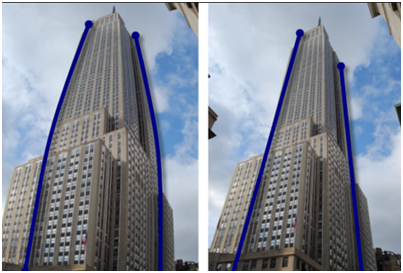
The difference between distortion and field curvature is that a distorted image is in focus at all points in the field of view.
Astigmatism
Astigmatism is similar to field curvature except the curved field has a different curvature in two different axes of the image. For example, the left to right axis of the image can have more or less field curvature than the top to bottom axis of the image. In geometric terms, an astigmatic focal plane is like the shape of a football where field curvature is like the shape of a basketball.
Riflescopes usually have some astigmatism which can be observed if it is significant. To see astigmatism point the scope at a target with vertical and horizontal lines that extend far enough to fill the entire field of view. A good target would be telephone pole and the connecting wires. If a scope had astigmatism a feature in one axis will have a different clarity than the axis 90 degrees apart. For example, the telephone pole would look sharp from top to bottom but the wires would blur out towards the ends or vice versa.
Regarding the design tradeoffs, a scope can be designed to have more field curvature and less astigmatism or less field curvature and more astigmatism. The degree of astigmatism is an image quality tradeoff in which a scope with some astigmatism can be considered a better design than one designed allowing relative more field curvature.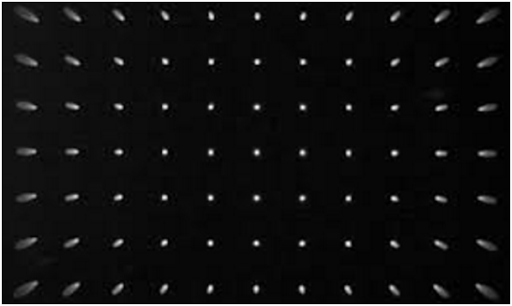
Spherical aberration
Spherical aberration occurs in an optical system because the light that passes through the edge of a lens is refracted more than when it strikes the center. Spherical aberration causes all areas of v the field of view to appear not as sharp. Spherical aberration is harder to control as the objective lens diameter and magnification increases. With large objectives and high magnification, the objective lens system requires more complexity in terms of the number of lens elements to meet most performance goals.. The metric for spherical aberration is how well the scope resolves small details. Spherical aberration can be expressed in units such as lines per millimeter, inches at 100 yards, or arc seconds of angle.
Spherical aberration in a lens is shown below
Fa – Where edge of rays come to focus
Fb – The best overall image sharpness (circle of least confusion)
Fc – When center rays come to focus (paraxial focus)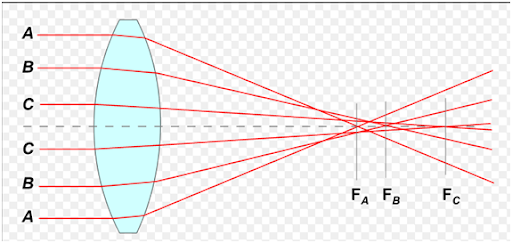
The challenge is to design an objective for a high magnification rifle scope with as large an objective as possible in order to collect more light and also provide low spherical aberration. It must be kept in mind that some manufacturers are pushed to sell scopes with large apertures but have not implemented a design to reduce spherical aberration. These products provide more light but will have poorly resolved images if the objective design is simple. An example is that some manufacturers reduce cost by making a 40mm diameter objective to be 50mm without redesign to minimize manufacturing cost. Typically a 40mm objective can provide good images using a cemented doublet lens and a 50mm requires going to a triplet design if one keeps the spherical aberration the same between the two objectives.
Coma
Coma aberrations are similar to astigmatism except comatic errors get equally worse in all areas of the field as you work your way out from the center to edge of the field. In other words, coma gets worse as the field increases. In riflescopes, coma is normally a small contributor to image clarity as its contribution is small compared to field curvature aberration. If coma is significant, one will see flares at the edge of the field. If the field consists of dots the outer dots will appear similar to a comet’s tail hence the term coma.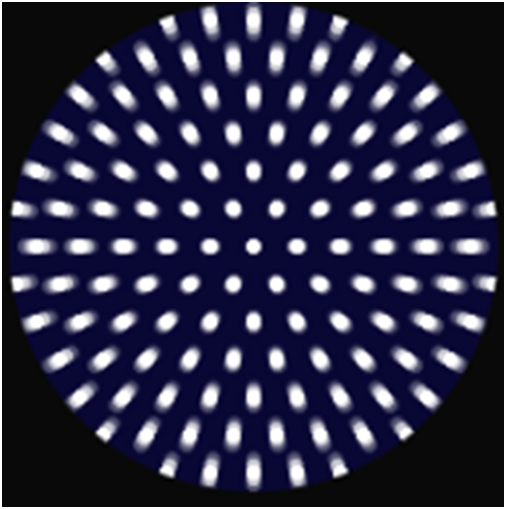
Below is an an exaggerated example of the coma effect
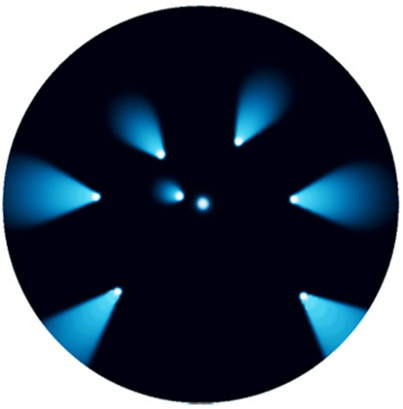
Chromatic aberration
Chromatic aberration is the inability for an optical system to focus all colors from an object at one point in an image. An optical design has always some residual effect of red, green, and blue colors not exactly coming together. Chromatic aberration appears at the edges or boundaries of object details as blue or yellow fringes of colors. Chromatic aberration is most easily seen when looking at a white object against a black background.
Chromatic aberration increases with magnification. In low power scopes, chromatic aberration is so small as not being noticeable. However, at magnification over 15 to 20 power, it is visible if not well controlled. High magnification optics can make use of low dispersion glass, referred to as ED glass, to help minimize this aberration but it is more expensive than the more common grades of glass. High power rifle and spotting scopes used for long-range observing are examples of product which require very significant control to reduce color aberrations. Chromatic aberration is important to control because it significantly reduces the ability to see fine details as well as give what is commonly referred to as false color.
Summary
Optical aberrations are unavoidable imperfections to an image. The challenge is to manage the aberrations to meet customers specifications as well as balance performance and manufacturing cost. As an optical system is being designed the engineer has to make decisions such as: should there be more elements or more exotic glass types, is the design goal to minimize product weight or length, or what demands are requiring optimization of certain performance parameters. Optical design is the same as other engineering tasks in that to improve performance 10% it can increase the cost 50%. With a given optical complexity, regarding the allowable number of lenses in a system, the engineer must balance all aberrations to maximize overall performance.
One might want to compromise more field curvature at low power to provide exceptional image sharpness across the field at high power. Some aberrations such as coma and spherical aberration, if considered unacceptable in a design, can only be improved by adding elements to the objective and/or eyepiece. To provide the very best overall design with the minimum number of lenses is a balancing act requiring back and forth trials. However, the required effort to meet all performance goals has been considerably improved by using modern optical design programs.
OPTICAL ABERRATIONS IN RIFLE SCOPES